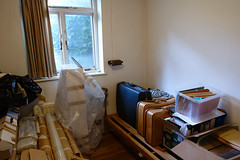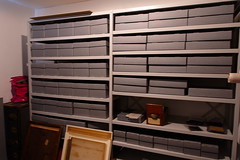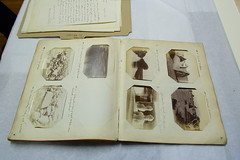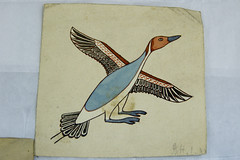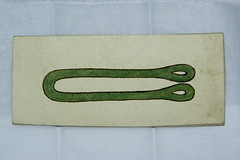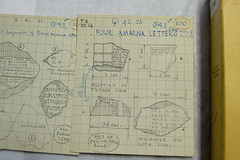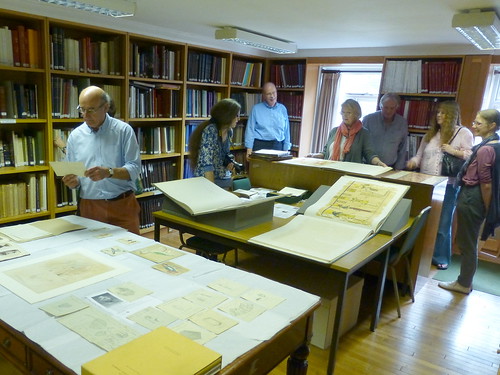Last Wednesday a group of us from the Essex Egyptology Group went to visit the Egypt Exploration Society‘s offices in London. Once we’d all arrived Jo Kyffin started off with a half hour talk on the history of the Society & an overview of what they do nowadays. The Society started life as the brainchild of a formidable Victorian woman called Amelia Edwards. She was (among other things) a novelist & travel writer, and in the 1870s she visited Egypt in part for the warm weather and in part to write a book about travelling through the country. This book was called “A Thousand Miles Up The Nile” and was written in an enthusiastic (and very Victorian) style – Jo read us a couple of excerpts from it. Although Amelia Edwards never returned to Egypt she became very passionate about the country. While she was there she’d noted what poor conditions many of the ruins were in, and how much damage was being done by tourists & locals removing things (to take home as souvenirs or to sell). And when she got back to England she decided she needed to Do Something About It. And Do Something she did. She set up the Egypt Exploration Fund in 1882 (which became the EES) as a subscription based fund that would send teams to Egypt to excavate and/or preserve the ancient sites. Almost as soon as the fund was set up & the first subscriptions were received the first excavation team was sent out.
The first expeditions were to sites in the Delta which had previously not received much attention, and they also concentrated on sites with some biblical link. Edwards was aware that biblical archaeology was fashionable at the time and felt this would be a draw for subscribers (particularly the American ones, apparently). Over time the scope of the Society’s work has broadened – they have several strands of work now covering different eras and time periods of ancient Egypt, including funding past excavations at Amarna. Various famous names in Egyptology have worked for the Society – including Pendlebury (who we had a talk on at the EEG in February (post)) and Petrie (there was an EEG trip to the museum that houses a lot of his finds in April (post)). Howard Carter (discoverer of Tutankhamun’s tomb) also worked for them while he was starting out in Egyptology – originally he was employed as an artist, making drawings of wall paintings etc.
As well as sending out teams to excavate in Egypt the Society also stores some of the data they bring back (I mean things like photographs, negatives, drawings etc) and works towards publication of the finds. This can take a considerable (and growing) length of time – some excavations have taken over 40 years to be finally published. Modern excavations the Society funds do things like blog while they are excavating – this means that subscribers can see what’s going on with the stuff they’re funding (as well as get other people interested in the Society’s work so they might subscribe in future). As part of our tour Jo showed us two rooms in the archive section of the offices. One of the two houses the offices are in was once owned by Ricardo Caminos who left it in his will to the Society – the photo on the left above shows what was once his bedroom still with some of the original fittings, and the piles of archival material sitting in there (they know what & where everything is, it just isn’t the most modern arrangement). One of the things the Society is working on is modernising the storage of all their archival material, and the photo on the right is one of the other rooms where that’s been finished. The grey boxes all contain glass negatives (they have about 15,000 of them), carefully & individually wrapped & labelled. They’ve all been scanned, but the originals still need to be there to go back to if necessary.
Some of the material the EES holds has become of historical interest in its own right, and they had got some of this out for us to have a look at. The photographs above show a handful of them – the photograph album is some of Petrie’s own photographs, in his own photo album, labelled by him. The two watercolours are by Howard Carter. And the index cards are for objects excavated from Amarna – if you read the text on the drawings of the tablets you can see that the person who wrote this card was bored! I’m fascinated with the index cards, we saw some of Carter’s at the Griffith Institute last year (post) as well – I’m not quite sure why they appeal to me, but there’s just something about having a tangible catalogue that I like.
The EES also have a very large library including copies of many large old books with reproductions of papyrii or wall paintings. So as well as looking at the archival material we had a look at some of those. After they finally dragged us all out of the library & away from all the shiny things Jo Kyffin finished off our tour by showing us some footage filmed at an excavation at Meir & Saqqara funded by the Society in the 1950s. As part of the curation of all their archival material one of the things the EES is doing is digitising all film footage that they have. The money from our fundraising booksale at the EEG last year had been sent to the EES to go towards this work, so what Jo was showing us was the piece that our donation paid for. It was a shortish (silent) piece showing a (fairly staged) day in the life of the excavation – get up, have breakfast, trace some wall paintings, prepare to descend into a tomb, that sort of thing.
It was an interesting afternoon 🙂 I’ve got a few more photos up on flickr here.

